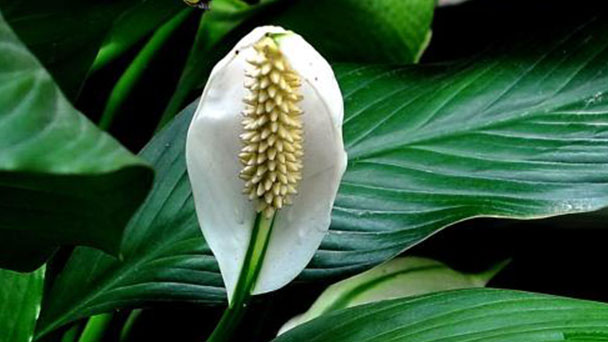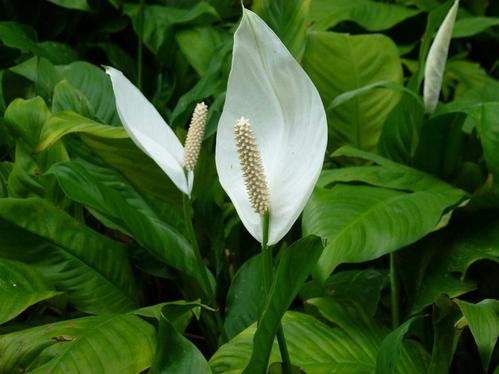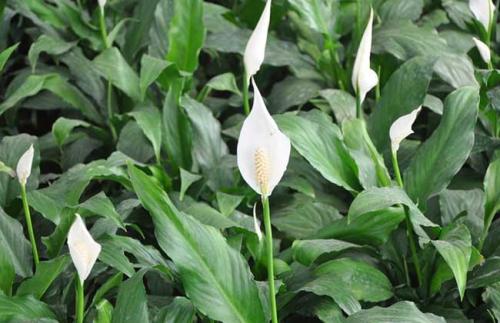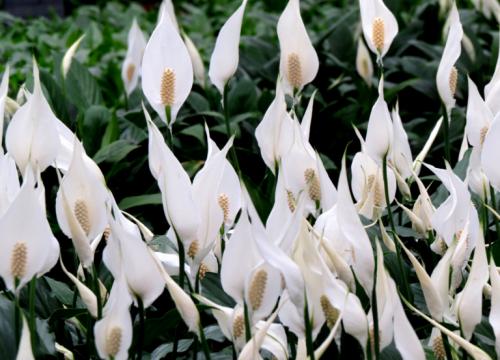Spathiphyllum kochii Engl Profile
Written by Maggie
Nov 08 2021

Spathiphyllum Kochii Engl is a perennial herb. It is the most important ornamental flower in the world. It's also a dab hand at filtering out indoor waste gas, and works against ammonia, acetone, benzene, and formaldehyde. In the early 20th century, it began to be used for potted plants.
Spathiphyllum Kochii Engl Picture

Spathiphyllum Kochii Engl Characteristics
Spathiphyllum Kochii Engl was born in tropical America. Prefer high temperature and wet and semi - shade environment.
The suitable growth temperature of spathiphyllum kochii engl is 22 ~ 28℃, 24 ~ 30℃ from March to September, 18 ~ 21℃ from September to March of the following year, and not less than 14℃ in winter. When the temperature is lower than 10℃, plant growth is hindered and leaves are vulnerable to freezing damage.
Spathiphyllum Kochii Engl has large leaves and is sensitive to humidity. When summer is high temperature and autumn dry, it needs to spray water more, ensure air humidity in the 50% above, and be helpful for leaf growth. When the high temperature is dry, the leaves are easy to curl, the leaves become smaller, wither and fall off, and the flowering period is shortened.
Spathiphyllum Kochii Engl is afraid of strong light exposure and needs shade of 60% ~ 70% in summer. However, it is not easy to blossom due to long-term lack of light. Consider 500 lux. Loam soil with fertile and rich humus content is preferred.
Spathiphyllum Kochii Engl Care
Spathiphyllum Kochii Engl is more shade tolerant. As long as about 60% of the scattered light can meet its growth needs, it can be placed indoors and cultivated in bright scattered light all year round. In summer spathiphyllum kochii Engl can block off 60% ~ 70% of the sun, avoiding strong light directly, otherwise the leaves will become yellow, seriously leading to sunburn disease. In north winter greenhouse cultivation, do not shade less. If long-term light is too dark, it is not easy to flower. Spathiphyllum Kochii Engl is a kind that likes high temperature, it should be cultivated in a high temperature greenhouse. The lowest temperature in winter should be 14 ~ 16℃ at night and 25℃ in the daytime. Long-term low temperature will easily cause leaf fall off or charred. During the growth period we should often keep the potting soil moist, but to avoid watering too much, pot soil long-term moisture, otherwise it is easy to cause root rot and plant yellow. In summer and dry season, you should often spray the leaves with a fine eye sprayer and sprinkle water on the ground around the plant to keep the air moist, which is very beneficial to its growth and development. In dry climates, low air humidity, new leaves will become smaller yellow, when serious yellow is off. We need to control water in winter, with basin soil moisture advisable. Potted Spathiphyllum Kochii Engl requires loose soil, good drainage and aeration, and can not use heavy clay soil. Generally we can mix with leaf rot soil, peat soil and a small amount of perlite prepared matrix; Add a small amount of organic fertilizer as base fertilizer when planting. Due to Spathiphyllum Kochii Engl's fast growth rate and large amount of fertilizer, liquid fertilizer should be applied once every 1 to 2 weeks in the growing season. Supply sufficient moisture at the same time, often keep basin soil moist. In high temperature periods we should also spray water to the leaf surface and the ground, in order to improve the air humidity. If the surrounding environment is too dry, new leaves become smaller, yellow, when serious yellow is off. In late autumn and winter should reduce the amount of watering, keep the pot soil slightly moist. Spathiphyllum Kochii Engl requires semi-shade or scattered light conditions, growing season beard shade 60% - 70%. If the light is too strong, the leaf is easy to burn, scorch, leaf color is dim, lose luster; Long-term light is too dark, plant growth is not robust, and not easy to flower. Spathiphyllum Kochii Engl is a species that likes high temperatures. Long-term low temperature and humidity are likely to cause root rot and ground parts to wither and yellow. Therefore, it is necessary to protect against cold and keep the soil moist in winter.

Spathiphyllum Kochii Engl Propagation
Germinate in 15 days. If the temperature is too low when germinating, the seeds are perishable.
Tissue culture: In the late 1970s and early 1980s, Spathiphyllum Kochii Engl began to breed in tissue culture in The United States and Germany. The young inflorescence and lateral buds as explants were disinfected and inoculated on MS medium supplemented with 10 mg/l 6-benzylamine and 2 mg/l indoleacetic acid, callus and adventitious buds grew after 40 ~ 45 days.
Adventitious buds were then transferred to MS medium supplemented with indoleacetic acid (2mg/l) for about 30 to 40 days to induce rooting and become intact plants.
Spathiphyllum Kochii Engl uses a mixture of leaf mould, peat and coarse sand, with a small amount of calcium superphosphate. Commonly used 15 ~ 19 cm basin. During the growing period, keep the soil in the basin moist, apply fertilizer once every half a month or use "hui You "20-20-20 general fertilizer. White crane taro tillering ability is strong, every year when changing basin, pay attention to root pruning and cut off withered leaves. After plant separation, the plants were potted.
Spathiphyllum Kochii Engl Pest Control
Common bacterial leaf spot, brown spot and anthrax infestation of Spathiphyllum Kochii Engl can be sprayed with 50% carbendazim wp 500 times liquid. Root rot and stem rot occurred. Pay attention to ventilation and reduce humidity, 75% chlorohydrin wettable powder 800 times liquid control. Sometimes scale insects and starfish harm, with 50% marathon oil 1500 times liquid spray control.
Spathiphyllum Kochii Engl Value
Spathiphyllum Kochii Engl, with its upright stems, is a delightful flower. The potted Spathiphyllum Kochii Engl is placed in the lobby of the hotel, the front of the whole audience, the entrance of the station and the window of the commercial building, which makes it look elegant and beautiful.
In the south, the configuration of small gardens, poolside, corner, unique. The flowers are also excellent decorative materials for flower baskets and flower arrangements.
The temperature of potted Spathiphyllum Kochii Engl was controlled at 13 ~ 16℃, the relative humidity was 80% ~ 90%, and it could withstand a dark environment for 30 days.

Latest Updated
- Benefits of Bugleweed - 7 Science-backed Health Benefits
- Bugleweed Dangers & Side Effects - Is It Poisonous?
- How to Plant Evergreen Trees - What You Should Know
- When to Plant Evergreens - Grow Guide for Evergreen Trees
- 12 Wonderful Evergreen Shrubs for Your Garden
- 12 Popular Evergreen Plants with Pictures for Beginners
- When And How To Prune A Lilac Bush Like a Pro
- How to Grow & Care for Lilac Vine (Hardenbergia Violacea)
- Japanese Lilac Tree (Syringa Reticulata) Care & Propagation Guide
- Shumard Oak Pros and Cons - What to Know
Popular Articles
- Winter maintenance of Antirrhinum Majus
- How to Grow Terminalia Mantaly Tree
- How to Grow and Care for Crossostephium Chinense
- How to grow Antirrhinum Majus in spring
- Peristeria Elata (Dove Orchid) Profile: Info & Care Guide
- Underwatered Snake Plant (Sansevieria Trifasciata) - Signs And How To Fix
- How to Care for Brazilian Jasmine Plant (Mandevilla Sanderi)
- How to Grow & Care for Graptopetalum Purple Delight in Summer
- Rosa Chinensis (China Rose): Plant Growing & Care Tips
- How to Care for Baby Sun Rose (Aptenia Cordifolia)